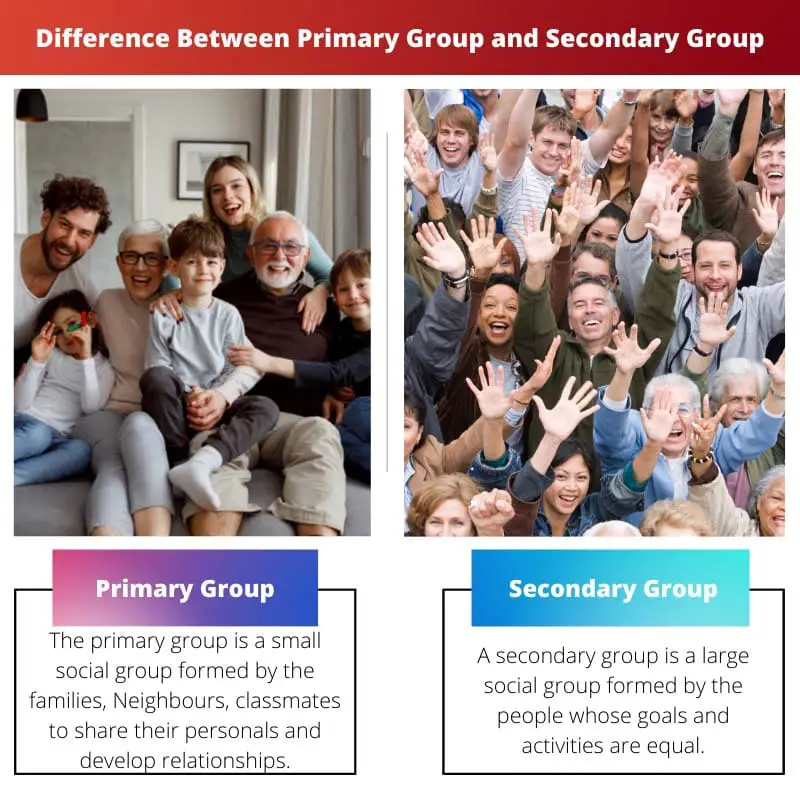Different types of social groups help people communicate and help each other in society. Social groups are useful in developing personal relations, engaging in social activities, and working on individual goals.
The Primary and Secondary groups are the social groups with minor differences formed by the people.
Key Takeaways
- Primary groups are small, intimate groups of people who share a strong emotional connection and personal relationships. In contrast, secondary groups are larger, more formal groups based on shared interests or activities.
- In primary groups, individuals are valued for who they are as individuals, while in secondary groups, individuals are valued based on their contributions to the group.
- Primary groups last long and are characterized by strong emotional bonds, while secondary groups are more transient and goal-oriented.
Primary Group vs Secondary Group
A primary group can be a small family group connected emotionally and socially. Family members can talk about personal issues in a primary group. The size of the primary group is small. A secondary group can be a huge social group of people with similar interests. A secondary group can also be a group of people who are involved in social activities.

The Primary group is one of the social groups formed by the family members. A primary group is a small group where family members engage and share personal issues. The Primary group had categorized as a small group that develops relationships.
Relationships between close people and friends may also form the Primary groups. The primary group plays a vital role in a child’s life that progresses the communication between people, and the child comes to know social awareness.
A Secondary group is one of the social groups formed by the people. People with the same activity and same goals shape the secondary groups. A secondary group is a large group that helps an individual to reach their goals.
The people in the Secondary group share their achievements and activities and do not engage in their relationships.
Comparison Table
| Parameters of Comparison | Primary Group | Secondary Group |
|---|---|---|
| Meaning | The primary group is a small social group formed by the families, Neighbours, classmates to share their personals and develop relationships. | A secondary group is a large social group formed by the people whose goals and activities are equal. |
| Engage | Members in the primary group engage in personal relations. | Members in the secondary group engage in social activities. |
| Group | The primary group is the first group categorized into the relationship development between people. | The secondary group is the inferior group in the social groups where people focus on their goals. |
| Characteristics | Small in size, Physical proximity, stability of the people, familiar background, self-interest, the intensity of shared interests are the characteristics of the primary group. | Short period, a large number of people, lack of rapport between members, impersonal, formal relationships, and specific aims for formation are the characteristics of the secondary group. |
| Examples | Share the views with the family members, sharing personal things with classmates, being free with close friends, and many others. | Allocate the basketball game views, share thoughts about the exams, and work on specific goals. |
What is Primary Group?
The primary group is one of the groups in social groups. The primary group was categorized as the social group’s relationship development group. It had a small social group formed by families, friends, classmates, neighbors, and close people.
In the primary group, people like to share their personal views, interests, and adjacent things. People form primary groups to engage with others and spend time happily.
The primary group plays a vital role in a child’s life that develops communication between people, and the child comes to know social awareness.
The characteristics of the Primary group are physical proximity, stability of the people, familiar background, individual self-interest, the intensity of shared interests, and small size. Small in number can engage with each other unboundedly.
The communication between the people in the primary group helps refresh an individual mind and leads to good health. Examples are sharing views with family members, sharing personal things with classmates, being free with close friends, and many others.

What is Secondary Group?
The secondary group is the inferior group of the social groups. The secondary group had categorized as the goal-gain group in the social group. It had a large number of people whose goals and activities were equal.
People with the same aims form these groups and share their views and information about their achievements and activities. Individuals did not like sharing their thoughts and feelings in the secondary group. The secondary group aims to reach its goals.
Short periods, a large number of people, lack of rapport between members, impersonal, formal relationships, and specific aims for formation are the characteristics of the secondary group.
Secondary groups are temporary groups and may end at a particular time. Examples are, sharing views about the basketball game, sharing thoughts about the exams, and working on specific goals. Secondary groups are team-based groups compared to primary groups.

Main Differences Between Primary Group and Secondary Group
- Primary groups formed the initial groups as social organization groups, whereas secondary groups were the inferior groups.
- Primary groups are small groups and long-lasting groups. In Contrast, secondary groups are the large groups and temporary groups.
- Primary groups were categorized as the relationship development batch, and Secondary groups were the goal-based groups.
- Personal activities and close things had shared in the primary groups. On the other hand, people with similar goals share their thoughts in the secondary group.
- Physical proximity, stability of the people, familiar background, and self-interest are the characteristics of the primary group, whereas short periods, lack of rapport between members, impersonal, formal relationships, and specific aims for formation are the characteristics of the secondary group.

- https://onlinelibrary.wiley.com/doi/abs/10.1288/00005537-198905000-00004
- https://journals.sagepub.com/doi/abs/10.1177/1368430215572266

This article provides a comprehensive explanation of the primary and secondary groups, examining their differences and applications in society. It offers a deep understanding of these social groupings and is an enlightening read for anyone interested in sociology.
Well said! It was indeed an insightful read.
I agree, this article is a valuable resource for understanding social relations and group dynamics.
The article offers a clear and accurate description of primary and secondary groups. It’s a great resource for those seeking to gain knowledge about social groupings and their significance.
Absolutely, this article provides a thorough analysis of primary and secondary groups, shedding light on their roles in social interactions.